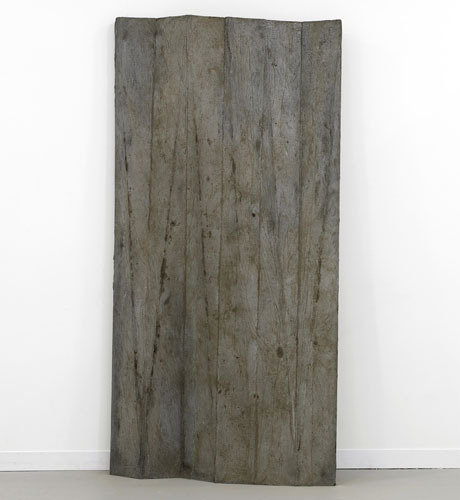Michael Dean
dal 10/4/2012 al 16/6/2012
Segnalato da
10/4/2012
Michael Dean
Henry Moore Institute, Leeds
Government. Dean's sculptures are either the perfect size to be carried or quote their surrounding architecture where they are then to be found lurking, propped against gallery walls.

Michael Dean's (b. Newcastle 1977) sculptures are either the perfect size to be carried or quote their surrounding architecture where they are then to be found lurking, propped against gallery walls. Made from cast concrete, the surfaces are veined and ridged, offering invitations to be touched. Tactility is an essential sculptural quality for Dean - he wishes us to first 'touch with the eyes, and then allow ourselves to touch with the hand'.
Government quotes from and transforms the Institute's galleries. The concrete floor has been covered with a thick, wool, wall-to-wall carpet, becoming something to touch, with the new surface changing the visual and sonic experience of the spaces. Instead of standing, the Institute's Information Assistants sit on the floor. The door handles at the entrance to the galleries have been recast as four forearm-sized sculptures, titled 'Yes (working title)' and two 'No (working title)'. These flat, grey, concrete bodies leave themselves no choice but to touched, their patina changing as the raw, unsealed surfaces pick up the traces of each person's hand.
Single, precise words are always the starting point for Michael Dean. His sculptures spell out their titles in an abstracted typography; here at the Institute the words he uses are government, yes, no, education, health and home. The term 'government' refers to the way human conduct is regulated. Dean is interested in how impersonal systems rapidly become personal when their direct impact rubs up against everyday experience. Government features three large cast concrete sculptures made on site at the Institute: 'Education (working title)', 'Health (working title)' and 'Home (working title)'. These are propped against the walls and sit firmly on the soft gallery floor, claiming both surfaces as their own. The sculptures copy, enlarge or reduce the architecture in turn. 'Health (working title)' repeats to a scaled-down ratio the dimensions of the gallery's longest and highest wall, as if applying the logic of a photocopier. This is not a practical sculpture: at over six metres long, it is too large to leave and at the end of the exhibition will be broken up and destroyed.
'Home (working title)' scales up the space between two galleries, to be then placed in front of the original volume and obstructs the route between them, leaving a gap to pass through, measuring the exact minimum legal limit. Slipped behind 'Home (working title)' is a room illuminated by a flickering light emitting from a large domestic plasma-display. The film, subtitled with one of Dean's texts written for Government, is a documentation of two photographs: one an image of an empty room filled with available light, the other a cabbage, a staple still life subject used in art classes. Sitting on an MDF backdrop, the surfaces of each photograph have been folded by hand, giving both a similar pattern to the surfaces of the sculptures. In this pose they are filmed in bright natural daylight, their surfaces reflecting changing external light conditions.
Sitting on the floor in each of the spaces are three spherical concrete sculptures: 'Analogue Series (Sphere)', 'Analogue Series (Head)' and 'Analogue Series (Cabbage)'. Each is head sized, its surface veined from the process of making. Each one of these sculptures has been photographed, with this image then folded in a sequence that spells out respectively sphere, head and cabbage. The resultant word is photographed on an MDF background, presented in an MDF frame. Dean's sculptures are always accompanied by intimate, observational texts exploring the object qualities of words. Using economical language he recounts human activities - for example watching television, making words in the mouth, or touching the hand of another. These texts develop alongside the sculptures, informed and informing them, to then be gathered into paperback books found amongst the sculptures that visitors are invited to rip out pages from to take away to read elsewhere.
'Analogue Series (Head)' sits on top of a thick paperback book collating a sequence of writings made for Government. Those who visit are invited to tear out pages from these diminishing paperbacks, which are replaced as soon as the last leaf is taken. In an unscheduled programme throughout the day, Dean's working notes leading to these texts are read aloud by Institute staff. Like government papers, these pages are subjective policies, documents written with a specific thought in mind that, once distributed, becomes subject to interpretation by others. Placing the spoken word in space is, for Dean, as much a sculpture as is any object.
Michael Dean studied at Goldsmiths College between 1998 and 2001. His work has been shown in solo and group exhibitions across Europe, including at Kunsthalle Frieburg in Germany, the Zabludowicz Collection in London, Nomas Foundation in Rome, MAK in Vienna and the Centre for Contemporary Art in Riga.
Image: Michael Dean, October (working title)' (2011), Reinforced concrete, Courtesy the artist and Herald St, London and Supportico Lopez, Berlin
Preview: april 11th, 18-20
Henry Moore Institute
74 The Headrow - Leeds
Hours: Tuesday - Sunday: 11am - 5.30pm
Gallery 4 open: Daily 11am - 5.30pm
Wednesdays until 8pm



